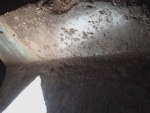Ancient mysteries: vitrified and moulded rocks
Perfect fitting, vitrified and moulded rocks
Many rocks have a strange look in Cusco and surroundings. As if they once were soft and have been moulded to give them form. They have a finish that gives them a look as a mirror, with a strong reflection, a shine, sometimes like metal or glass.
The 'Sacred Rocks' of the first style
Of the other two styles, the first one is the style were rock in situ was treated. The appearance is like cut cheese or butter. Many times large pieces of stone are removed and the finish is perfect, with forms that appear like our modern package material (foam), with rounded internal corners. The rocks like that can be found in all vestiges considered Inca, and normally in the centre or below the other 2 styles. We can find these treated rocks also in many other places without the other 2 styles. Often they form something like an altar, and till present times they are places were people make offerings and do the worshipping to the earth or ''Pacha Mama''.The second style of perfect fitting stones that once were soft
The second style is the style of the perfect fitting stones. Walls were not even a needle enters between the stoneblocks. They can be found in different forms and sizes, but the general characteristic is the perfect fit. Also these stones have a part that is vitrified, this is at the borders. Sometimes also on other parts of the stoneblocks we can recognize vitrification. Another characteristic of these walls is the blueprint that the upperlaying stones left on the lower laying stones, as if the weight of the upper stones gave the print in the once softer underlying stones.Orthodox science has no convincing explanation
These two styles can clearly be identified. For the eye the moulding and vitrification are obvious once you know how and where to look. Still orthodox science has other explanations. We have to realize though that there are just a few investigations that really gave importance to this phenomena. A serious investigation with includes anayzing stones etc. did not happen as far as I know, except maybe Protzen, who said he can reach similar results with polishing. He did that with only Andesite as a small proof. I do not consider polishing as a serious option to explain all the observed phenomena. The option that Alfredo Gamarra speaks about, with stones having been moulded and vitrified, is more logic. Some special technique must have been used by the ancients to be able to reach these astonishing results.
A list of arguments in favor of a special technique
So definitely a special technique was used, a conclusion that is based on the following arguments:-All the time the melted look is present and obvious.
-The reflection is strong.
-A layer is present at the surface where the vitrifcation is visible, sometimes the layer is interrupted because of some damage that occurred, and there this layer is clearly visible as a small ´film´ over the stone, this is independently of he type of rock.
-The surface is completely smooth for the touch in all cases, although the surface can be irregular (so it would have been extremely difficult to polish this irregular surface).
-The scale and the repetition and the form of the phenomena is such that the factor time and the difficulty to reach the precision doing it with carving and polishing, must be considered as ''not very probable'' and ''absolutely not common sense''. Useless for the Incas to do these kind of things and to spend so much time.
-Others have shown that many of these stones are magnetic, so something special happened with these rocks.
-The color on the treated rocks many times is different compared with the same but not treated rock nearby.
-On the perfect fitting stone walls we see very small pieces of stone of lower blocks, entering to occupy the small space between the upper laying blocks, as if the weight of the upper laying blocks pressed the once soft stone below to go there, these very thin pieces of rock would have been broken if polishing and smashing with other stones or using metal tools would have been the method of construction. This can be observed in the walls of Koricancha for example.
Repeated observation of all the phenomena mentioned above in all so called Inca vestiges, which includes different types of stone, and both construction styles: the walls with perfect fitting stones and the rocks 'in situ'
A few more considerations
1. A scientist that did detect vitrification was late prof. Watkins. He said:
"The rock surfaces on Inca stones are similar to those that have been thermally disaggregated". Indeed, some of the slick surfaces on the Inca building stones are glazed, so it becomes apparent that the Incas must have used thermal disaggregation.
2. Metal Clamps and T-grooves.
The use of Metal Clamps in T-Grooves happened in Tiahuanaco, Ollantaytambo, Koricancha and the site of Yuroc Rumi, Vilcabamba. Also in Egypt the use of clamps was found. The grooves appear to be limited to the most monumental structures, as the size of the blocks in which they were used is huge. At the site of Pumapunku, Tiahuanaco, a number of grooves still can be observed. Some say the metal of these clamps is from a very special alley, others say it is of a composition that is perfectly normal for the bronze technology of the Tiahuanaco culture.
The interpretation of the use:
Why would the builders use or need a small metal clamp to hold large stone blocks in place? This is the reason that some consider that the clamps were for ceremonial use, as the effect for construction use would be very limitted, namely the size of the blocks is too big compared with the size of the T-grooves and clamps. See: http://www.adventurespecialists.org/tgroove.html But Alfredo Gamarra said that the perfect fitting blocks do so because they were moldable on the moment of construction. If Alfredo was right, one can imagine that especially bigger blocks were more difficult to treat, as the weight of the clay-like block would have given problems to keep them in place, and the clay could have had the tendency to deform. The clamps would have served for keeping the blocks together, so they would harden out in the right position. The observation that the groove has been polished is important here. The same can be observed on the borders of the stones of the perfect fitting walls. Some technology with heat was applied to give form and strength to the construction. This means the shine is not because of polishing, but would be vitrification. The same counts for the T-Grooves. From the picture of the stoneblock with the T-groove in Ollantaytambo, it can be observed that also a bigger part of the stone is vitrified, not only the part of the groove.
And from the book 'The lost tomb of Viracocha', by Maurice Cotterell:
"Many scholars believe the straps were melted locally, and then poured into the grooves in the stones, because microscopic marks embedded in the straps can be seen to imitate corollary marks found in the stone. But as figures 39 and 40 explain, if the straps had been poured in situ, then the surface of each strap would be expected to be slightly convex, due to influence of surface tension experienced in the casting process. Secondly, the straps themselves would have adopted a cast line caused by the crack between the stone blocks, but the stones do not feature such a mark. A closer look at one of the blocks shows a discoulored outer layer of stone. It is as though the surface of the stone has been somehow 'softened' and later hardened, permitting the introduction of the ready-formed copper strip. This would explain away the flat-topped nature of the straps and the absence of the inter-block cast line."
So what does this mean? The clamps would have been put into the stones being these in a soft state, and the clamps would have been hard already! There is vitrification near the clamps to be seen, see this picture of Ollantaytambo: Clamp Ollantaytambo
Is this conclusion of vitrified and moldable stones the same as with the theory of the geopolymeres of the pyramids in Egypt?
No this is not the same as where the frenchman Joseph Davidovits is speaking about. He indicates that stones of the great pyramid were made out of cement, or geopolymeres. See: davidovits.info. But there are interesting coincidences with Alfredo Gamarra's ideas:
-Stone on the moment of construction was soft and moldable.
-Because of this, the stones fit perfectly.
But the differences are:
-The construction style of perfect fitting stones has been done with different types of stone, what means that for every type of stone there should have been a formula for the making of cement. Something that is much more complicated, so less probable as an explanation.
-The use of cement is not completely logical; why has each stone another form and size? More logical it would have been to use a mold and in this way a standard size of stone, to make the construction- work easier.
The proposal of Alfredo Gamarra means that every stone can be unique in size and form, but that at the same time, without any complications, they fit perfectly together. Making a mold for each stone would have made the work unnecessarily more laborous and more complicated.
Pictures and videos
Vitrification is everywhere, see the pictures on the right and the chapter 'Vitrified Stone' from our documentary. As stated before, vitrification is to be seen in all the Inca vestiges. See the pictures on the right and the video below. We present this video as a courtesy, at the same time you can get an impression of 'The Cosmogony of the 3 worlds' and the interesting and fascinating information and images that you can expect in this documentary. On the DVD this chapter is to be seen in full DVD quality of course. For your information: in this example chapter of the DVD, two terms are mentioned that might be unknown to you:1. The Hanan Pacha time period. This is a reference to the first orbit with human life. A time with less gravity, when the earth was closer to the sun. Speaking about the 'Sacred Rocks' of the first style, we refer to this period. The constructions were made in the rocks themselves, those rocks that nowadays form the base of many ancient vestiges. Especially those of the Inca's, but also in Egypt and other places. See 'Other ancient cultures'.
2. The Uran Pacha time period. This is the next period, in which the style of pefect fitting walls was made. This period was before our present period.
In both periods, vitrification was used, which can be observed on the video:





























